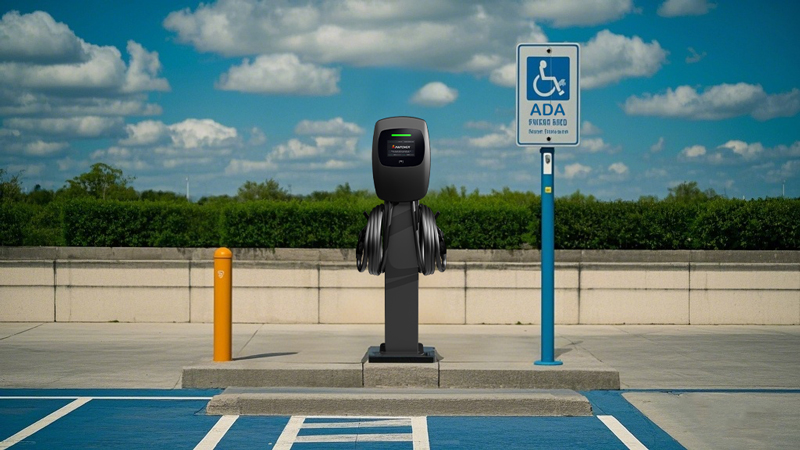Understanding ADA Standards
The ADA mandates that public amenities, including EV chargers, are accessible to individuals with disabilities. For charging stations, this primarily focuses on accommodating wheelchair users. Key requirements include:
- Charger Height: The operating interface must be no higher than 48 inches (122 cm) above the ground to be reachable for wheelchair users.
- Operating Interface Accessibility: The interface should not require tight grasping, pinching, or wrist-twisting. Buttons and screens need to be large and user-friendly.
- Parking Space Design: Stations must include accessible parking spaces at least 8 feet (2.44 meters) wide, located next to the charger, with sufficient aisle space for maneuverability.
These standards ensure that everyone can use charging facilities comfortably and independently. Grasping these basics sets the foundation for compliance.
Practical Design and Installation Tips
Creating an ADA-compliant charging station involves attention to detail. Here are actionable steps to guide you:
- Select an Accessible Location
Install the charger on a flat, obstacle-free surface near accessible parking spaces. Steer clear of slopes or uneven terrain to prioritize safety and ease of access. - Set the Right Height
Position the operating interface between 36 and 48 inches (91 to 122 cm) above the ground. This range suits both standing users and those in wheelchairs. - Simplify the Interface
Design an intuitive interface with large buttons and high-contrast colors for better readability. Avoid overly complex steps that could frustrate users. - Plan Parking and Pathways
Provide accessible parking spaces marked with the international accessibility symbol. Ensure a smooth, wide path—at least 5 feet (1.52 meters)—between the parking spot and the charger. - Add Assistive Features
Incorporate audio prompts or Braille for visually impaired users. Make screens and indicators clear and distinguishable.
Real-World Example
Consider a public parking lot in Oregon that upgraded its EV charging stations to meet ADA standards. The team implemented these changes:
• Set charger height at 40 inches (102 cm) above the ground.
• Installed a touchscreen with audio feedback and oversized buttons.
• Added two 9-foot-wide (2.74-meter) accessible parking spaces with a 6-foot (1.83-meter) aisle.
• Paved a level, accessible route around the chargers.
This overhaul not only achieved compliance but also boosted user satisfaction, drawing more visitors to the facility.
Insights from Authoritative Data
The U.S. Department of Energy reports that, as of 2023, the U.S. has over 50,000 public EV charging stations, yet only about 30% fully comply with ADA standards. This gap highlights the urgent need for improved accessibility in charging infrastructure.
Research from the U.S. Access Board underscores that compliant stations greatly enhance usability for people with disabilities. For instance, non-compliant setups often feature unreachable interfaces or cramped parking, posing barriers for wheelchair users.
Here’s a table summarizing ADA requirements for EV chargers:
Why Compliance Matters
Conclusion
Post time: Mar-24-2025


